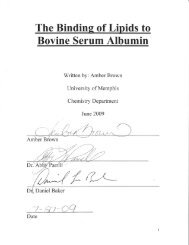Quiz QSAR QSAR The Hammett Equation
Quiz QSAR QSAR The Hammett Equation
Quiz QSAR QSAR The Hammett Equation
You also want an ePaper? Increase the reach of your titles
YUMPU automatically turns print PDFs into web optimized ePapers that Google loves.
Important Implications<br />
• σ values implicitly account for the influence of<br />
solvation (H-bonding, dipole-dipole)<br />
• No consideration of geometry is included<br />
• Problematic if steric interactions cause a change<br />
in electronic character<br />
H H<br />
N<br />
X<br />
is very electronically different from<br />
• Problematic for extensions to flexible systems<br />
• Conformation is implicitly included<br />
R<br />
HH<br />
N<br />
X<br />
R<br />
CHEM8711/7711: 7<br />
Limitations<br />
• Ortho substituents often interact sterically<br />
• σ values are determined in water, for H-<br />
bonding substituents may see problems for<br />
non-aqueous phenomenon<br />
• Reactions often change mechanism when<br />
substituents with drastically different<br />
electronic characteristics (σ) are present<br />
• σ for charged groups is dependent on the<br />
ionic strength of the media<br />
• Direct resonance can cause problems<br />
CHEM8711/7711: 8<br />
Hansch’s Application of the<br />
<strong>Hammett</strong> <strong>Equation</strong><br />
• Biological activity of indoleacetic acid-like<br />
synthetic hormones<br />
Log (1/C) Versus Log (P)<br />
Poor bioavailability<br />
• Log(1/C) = -k 1 (logP) 2 +k 2 (logP)+k 3 σ+k 4<br />
• C: Concentration having a standard response in a<br />
standard time<br />
• P: Octanol/water partition coefficient<br />
• Log P reflects pharmacokinetic influence on activity –<br />
does the compound get where it needs to go?<br />
• σ reflects pharmacodynamic influence on activity –<br />
does the electronic nature of the compound induce<br />
activity?<br />
• Why is there a squared log P term?<br />
CHEM8711/7711: 9<br />
log 1/C<br />
-3 -2 -1 0 1 2 3<br />
log P<br />
Compounds that are too polar<br />
will not partition into<br />
membranes in the first place<br />
Compounds that are not polar<br />
enough cannot partition back<br />
out<br />
CHEM8711/7711: 10<br />
Importance of Hansch’s Work<br />
• Demonstrated that biological activities could<br />
be quantitatively related to physical and<br />
chemical characteristics<br />
• Developed a group-additive method for<br />
calculating log P (so that compounds could be<br />
predicted prior to their synthesis)<br />
• Utilized a <strong>QSAR</strong> equation to assist in<br />
developing a physical interpretation or<br />
generalization about biological activity<br />
CHEM8711/7711: 11<br />
Descriptors<br />
• Descriptor: A numeric representation of<br />
structure<br />
• Descriptors used in the Hansch approach<br />
(log P, σ) are empirical (derived from<br />
experimental observation)<br />
• Limitations<br />
• σ is a substituent descriptor -> won’t be<br />
applicable to non-congeneric series<br />
• Log P is an experimentally determined value -> a<br />
computational method is needed before it can be<br />
used to make predictions<br />
CHEM8711/7711: 12<br />
2
















